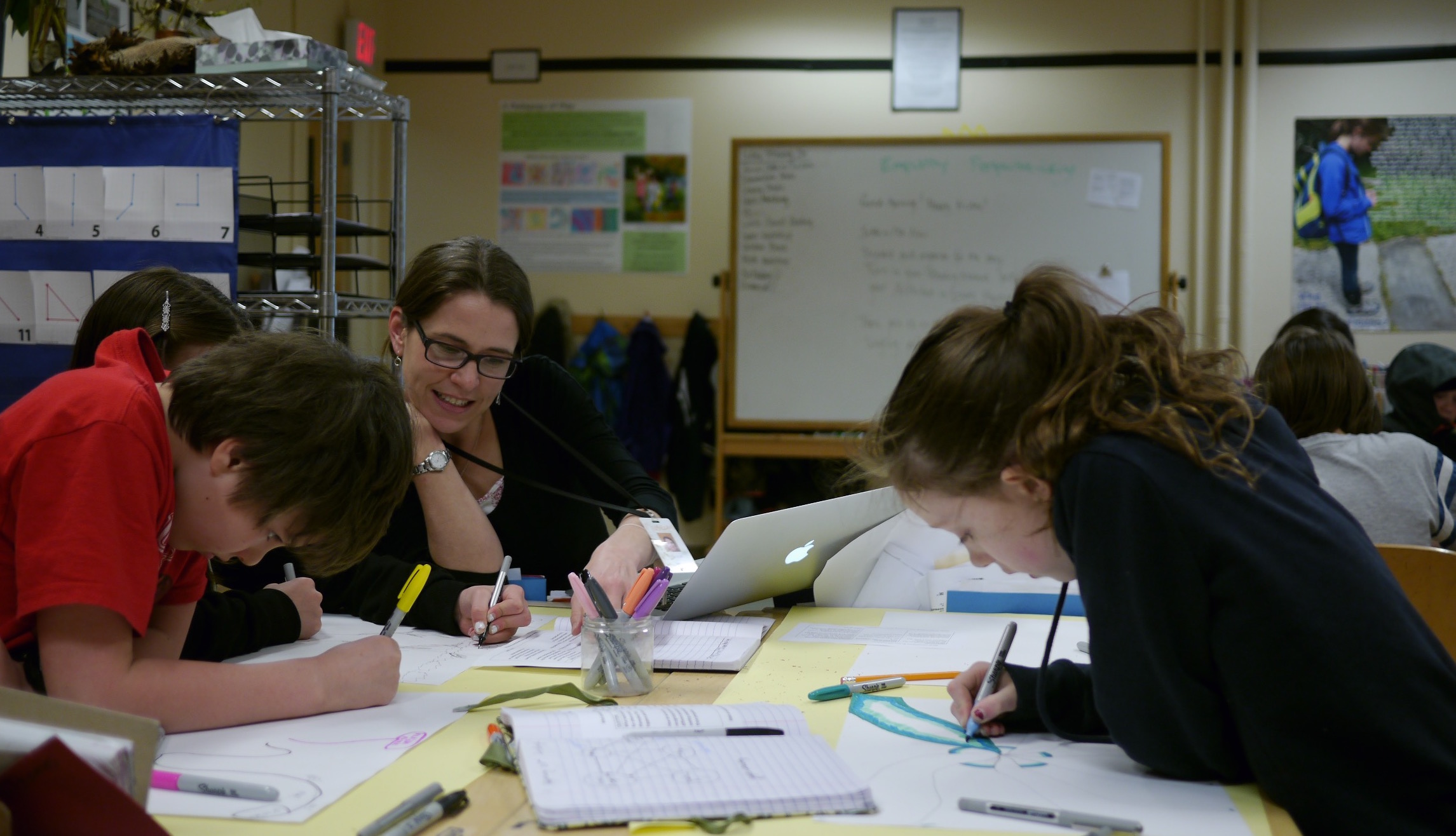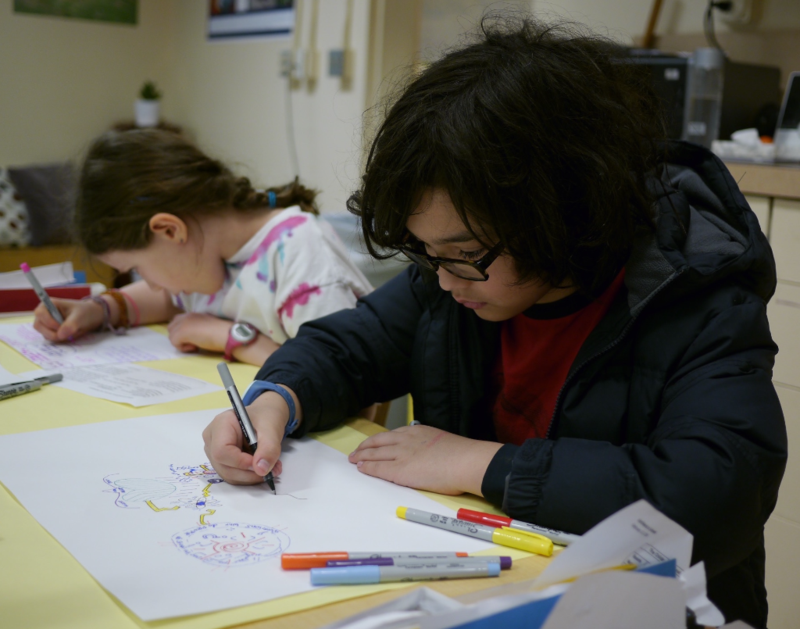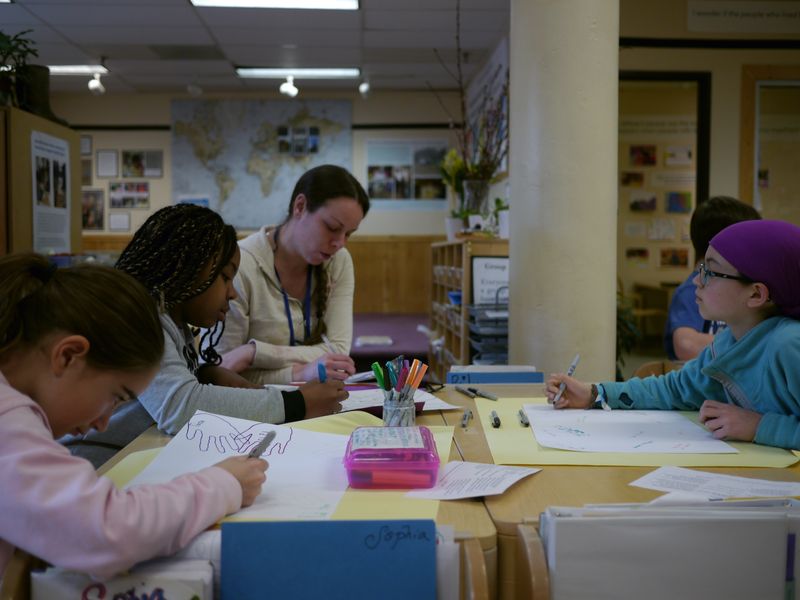Constructing new ideas through dialog and the arts

During a recent Opal School Mentorship Program gathering, a group was discussing the quality of conversation they hear in Opal School classrooms. They were intrigued by the ways in which children see each other as “brain buddies”, creating ideas together – a discursive environment where, in order for someone to be “right”, others didn’t need to be “wrong.” They referred to conversations that seemed to flow in organic, authentic ways. Inspired by their observations, they were shifting their approaches to conversation in their classrooms – altering their roles, the nature of questions they were employing, the way they were listening – and were excited by the results.
One foundational support for this practice is the way in which classroom communities are developing complex worlds to draw upon. Earlier this week, I was asked by a visiting educator about a line of inquiry under investigation in the Magnolia Classroom. She asked me, “How long have they been studying seeds? When did this study start?”
 It struck me that the investigations underway must have appeared to her like those she might see in many elementary school classrooms, where a defined unit of study would have a start date and an end date, likely repeated annually and, once culminated, done. At Opal School, the question of seeds is more like seeds themselves: experiences harvested from prior experiences and conversations that themselves grow and cast out new seeds, engendering new growth that evolves in unexpected settings. Because of this complex landscape of ideas, teachers need to be prepared for the novel ways in which ideas will come together given the wide range of experiences these communities have lived together. When Steven Johnson says that “chance favors the connected mind,” I think he is pointing to what leads to such great conversations in Opal School classrooms.
It struck me that the investigations underway must have appeared to her like those she might see in many elementary school classrooms, where a defined unit of study would have a start date and an end date, likely repeated annually and, once culminated, done. At Opal School, the question of seeds is more like seeds themselves: experiences harvested from prior experiences and conversations that themselves grow and cast out new seeds, engendering new growth that evolves in unexpected settings. Because of this complex landscape of ideas, teachers need to be prepared for the novel ways in which ideas will come together given the wide range of experiences these communities have lived together. When Steven Johnson says that “chance favors the connected mind,” I think he is pointing to what leads to such great conversations in Opal School classrooms.
Friday, the fourth and fifth graders held a conversation with the intention of finding relationships between some big ideas, questions, and experiences. What follows are some snippets, condensed from a longer transcript, revealing what that sounded like. The images are of children aiming to make their ideas about these connections visible; the materials, as always, proving supportive in constructing complex, trans-disciplinary theories. Unattributed sentences are from teachers:
We have some questions posted that we’re we’re curious to hear some thinking about: What leads people to act for others as well as themselves? What happens when they do?
Do you have a connection – what is your brain thinking about?
…
LD You might see people, well you might have been treated rudely and you might think about how it felt to you and you don’t want other people to have to feel that. Some people might want to stir it up but others might want to stop it.
RB Can I add on? When it says what happens when they do, I think you might gain trust with whoever that person is.
SM We can’t do this work without making an assumption, like it’s different from every person. When people act for others it could be different each time. Their reaction might be different. Are we thinking about what would happen if we did it or as a whole?
Yes to everything. I heard you say you can act for yourself or others but how it might be different and it might be interpreted differently. Is there a thread or a quality or condition that might be the same across really different situations?
SM Probably – there might be. People might act the same way. Like didn’t that just happen the other day?
KC – I was really thinking about the word lead and trying to make sense of it by replacing it with something else so I wondered what makes people. What changed their mind – is it that specific moment or something that already happened? What leads them, what influences them?
What happens if you don’t?
CR Selfish. Like at school you might cover up your spot.
You’re saying you might just be thinking of yourself. When we think about the stories of history and what happens in our everyday lives, what is it that either allows or leads or compels or helps or supports people? Why do people choose to either just act for themselves or act for themselves and other people? What is that? We know stories where today or in the stories of the past where someone has only acted for themselves for their interests and when people have acted for themselves and others?
MC You have to give and take in a community. Like in that book The Giving Tree, it was only taking.
ED They didn’t have any interdependence.
Is that idea [of interdependence] related to this question?
ED Yes.
PK It’s like this book I am reading where people are starving and people are gone and this girl finds an apple and she cuts it up and gives parts of it away. She’s helping everyone instead of just herself. There is this other girl who doesn’t realize the town is starving and she doesn’t realize that they need even the half of apple she didn’t eat.
What leads one person to act for others in a situation where someone else didn’t?
PK If you don’t know how it feels, you don’t know what they need.
What’s the word for that?
MC Empathy
SM Empathy is up there!
ED rereads a documentation panel, related to Opal 3’s work last year
SM Adding on to what Pritam just said, you have to really be there or watch. Even if you are not in that exact place, you can watch that person be sad and upset, you can relate to it even if your experience is not exactly the same.
…
This makes me think of perspective. Can you act for yourself and maybe some others and maybe exclude a whole other group of people?
ABM It’s like Columbus – he thought he was helping the natives but he was also getting land and money.
Lots of voices join in.
LD Well maybe he knew what he was doing but he was really acting for himself. He thought they wanted to come with him….If you master this one you can do this one. If you can take other perspectives that can be what leads you to act for others as well as yourselves.

Especially in the midst of this election season, it’s hard to read dialogs like this and feel that the quality of listening and relationships, the interest in considering multiple perspectives, and the eagerness to practice empathy stand in stark contrast to so many other conversations circling around us. Children and adults alike have a deep desire to listen and be heard while making meaning of the world with others. It’s up to all of us to keep exploring the conditions that support this basic desire of all humans.

The potential implications of these types of conversations cannot be overstated!